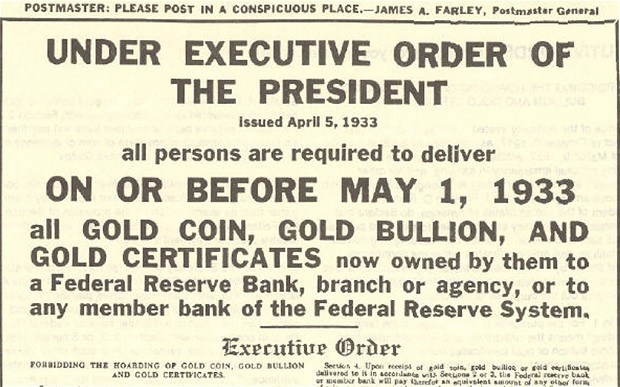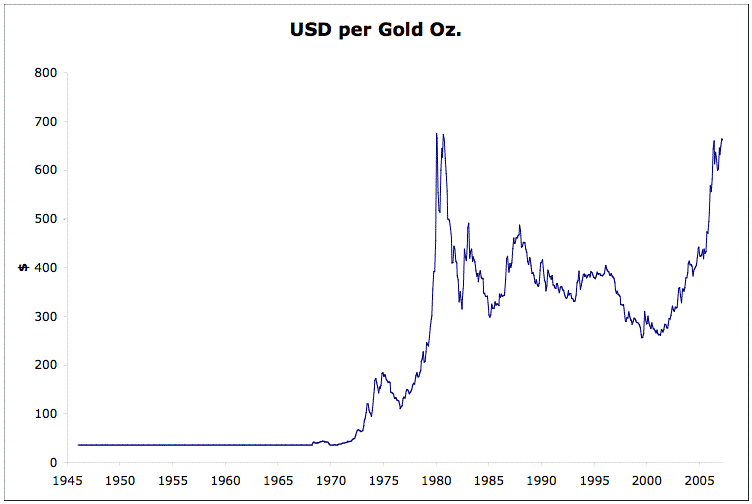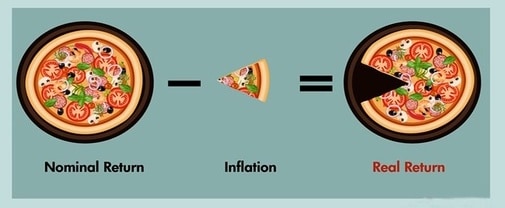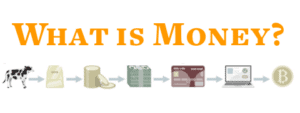The US dollar has clearly ‘devalued’ — lost its value and purchasing power — over the past century and more, but why this has happened remains a mystery to many of us. I did some research on the history of the dollar and the US banking system to give you a better understanding of the reasons behind the gradual devaluation of the dollar.
According to United States Federal Reserve Bank data, as of April 2020 the US dollar lost 96.2% of its value since 1913. The main cause for this devaluation is persistent money printing by the US Federal Reserve bank and federal government to fund budget deficits and bailouts.
This money printing essentially taxes all holders of US dollars, and uses that taxed value to fund US government contracts, defense spending, wars, social security, and even bank bailouts. The US dollar, however, was not always on a downward path – devaluation accelerated after a little-known event called the ‘Nixon Shock’ in 1971.
Short History of Dollar Devaluation
Before 1913, dollars went through several phases where the the value of the currency was backed by different commodities, such as gold and silver. In 1913, the Federal Reserve bank, a privately-owned central bank created by the owners of all the major banks at that time, took over the US monetary system and began circulating paper US dollars backed by gold. At this point, about 19 dollars was equivalent to one ounce of gold.
In 1933, heavy government spending aimed at propping up the failing economy created a shortfall in government revenues that needed to be filled. To finance their spending, the US government confiscated gold from citizens through Executive Order 6102, buying the gold owned by citizens for 20.67 dollars per gold ounce. Shortly thereafter, the government raised the price at which they sold gold from $19/ounce to $35/ounce, capturing a large profit at the expense of citizens by lowering the value of the currency relative to the gold backing it.

In 1944, the US dollar became a critical part of the global economy with the Bretton Woods agreement. Through this agreement, most of the major global currencies were tied to the US dollar at a fixed exchange rate, with the dollar backed by gold at a rate of $35/ounce. However, the US government continued to print dollars so that the dollar was not fully backed by US gold reserves at the stated exchange rate. The dollar slid in value against goods and services from 1944 through the 50s and 60s due to government deficits to finance the Vietnam War and social programs, as evidenced by the Consumer Price Index data collected by the US Bureau of Labor Statistics (chart below).
With the dollar barely still backed by gold by the 1970s, Nixon unilaterally changed the global monetary system by taking the dollar off the gold standard in 1971. This created the system we have today, which allows all central banks around the world to freely print and devalue their currencies. Instead of all currencies being ‘pegged’ to the dollar, national currencies are allowed to freely float against each other.
While the dollar remains strong amongst other global currencies, this is only because the values of all global currencies fall together against the value of goods and services. Since 1971, the dollar has lost 84% of its value in terms of the goods and services it can buy.
How the Federal Reserve creates money
The Fed creates money when they purchase public (government) or private (corporate) debt. For example, the Fed buys Treasury bonds sold by the US Treasury. These Treasury bonds are a form of debt – the government sells them to the Federal Reserve and other buyers, receiving cash it can spend now in exchange for an obligation to pay those investors back plus interest. This allows the US government to continue to pay its bills, including the interest they owe on past sales of Treasury bonds.
The Fed is a special buyer of Treasury bonds because they do not use money they earned to buy those bonds – they simply print the money, or enter it on a digital ledger. All central banks do this. When this newly printed cash enters the economy through government spending, it devalues the dollar. The value of the currency is now inextricably tied to the government.

Before 1971, the US government had to keep a relatively tight budget, because foreign governments knew deficits caused more dollars to enter circulation and devalued all existing dollars and currencies pegged to the dollar. This would cause foreign governments, like the French, to redeem their dollars for gold – which made it even harder for the US to back the dollar with gold at the official exchange rate of 35 dollars per ounce of gold.
After 1971 and the ‘Nixon Shock’, the government could run larger deficits and spend more freely, with the only consequence being increased inflation.
This inflation hurts savers and those who work for a fixed wage, but the American government has so far successfully convinced the public that inflation is a healthy and necessary part of economic growth. However, constant inflation is simply a wealth transfer: it takes from those who work for wages and save their money, giving that value to individuals who take on loans and use them to invest in assets like stocks, real estate, and other stores of wealth for the well-off.

A central bank also increases the amount of money in circulation by lowering interest rates, providing increased ‘liquidity’ to banks, and through direct cash handouts called ‘bailouts’. Lower interest rates encourage individuals and businesses to take out loans. When new loans are extended by commercial banks, new currency enters circulation. When this currency enters circulation, it also devalues all the other currency already in circulation.

We do not see this devaluation show up in exchange rates between currencies because all modern currencies are engaged in this same tactic. No currency is pegged to a supply-constrained commodity, so when one central bank devalues their currency, other banks are pressured to devalue their currency as well.
This pressure comes from foreign exchange rates, which affect exports and imports. When a country’s currency is more expensive relative to other countries – because their central bank did not devalue fast enough – that country’s exports become relatively more expensive to other countries, and therefore that nation loses buyers and revenue. This drives most central banks to continue devaluation of foreign exchange rates in line with their trading partners.
The role of the Gold Standard in the United States
For thousands of years, gold has served as a currency through multiple civilizations and empires due to its durability, portability, and difficulty to mine. Pure gold is unlike all other commodities on Earth in that it is difficult to produce more units of gold. We can quantify this difficulty through the stock to flow ratio, which is explained in this post.
When other types of currency suffer from overproduction, we humans tend to hoard gold to protect our savings against the hyperinflation that results from too much currency production. Constant inflation, also known as debasement or devaluation of the currency, brought down many past empires such as the Roman empire.
The gold standard in the United States served to balance power between the government and private citizens, since neither could produce gold cheaply and use it to purchase goods and services. Paper dollar bills were simply representations of gold. In fact, the Constitution clearly states the importance of backing all currency with precious metals: “No State shall… make any thing but gold and silver coin a tender in payment of debts” (Article 1, Section 10).
However, the United States government slowly moved away from the gold standard by printing more paper bills without backing them with gold, and eventually severing the tie completely in 1971. Now, the United States government can effectively produce any amount of dollars for zero cost – by asking the Federal Reserve to type a few zeros in a computer – with the promise to repay it later.

This only works as long as the American public continues to pay taxes in dollars, oil continues to trade mainly for US dollars, and foreign governments like China continue buying US government debt. This all creates demand for the dollar – if that demand decreases, the dollar could collapse.
Imagine how powerful you would be if you could edit your bank account balance! That’s the power the US government has now that we are off the gold standard.
What to own when the dollar collapses
Protecting yourself from devaluation and eventual collapse of the dollar means owning ‘sound’ assets that cannot be inflated in supply. Even financial assets, like mutual funds, and commodities like oil, can be inflated in supply by financiers and producers.
The best assets to protect yourself in the event of a collapse of the dollar are gold and Bitcoin. Both of these assets are the hardest to produce in the world, which makes them very difficult to inflate in supply. As a result, their value is likely to remain steady and possibly greatly increase as the dollar and other ‘fiat’ currencies devalue.

We saw an example of this in the late 1970s, when high inflation struck the US economy and gold rocketed about 1000%. Interestingly, today’s gold price now dwarfs the peak here, sitting at $1,700 per ounce as of May 26th, 2020.
How the devaluation of the dollar affects you
The Federal Reserve and US government, as well as other governments engaged in systematic devaluation, justify this practice by saying that it drives investment in businesses and relieves debt burdens.
While these claims are both true, they overlook basic economics. Devaluation means currency loses a steady amount of value each year, say 2% – also known as a 2% price inflation rate. This means you are better off investing in any business you think will have a real return of less than negative 2% per year. Crazy, right!
Keep in mind that a real return of 0% means that whatever amount of currency you receive back, its value in terms of what it can buy has not changed. For example, with an annual price inflation rate of 2%, $100 in year 1 is equal to $102 in year 2, in terms of what that currency can buy.

If currency instead stayed stable, at 0% loss or gain in value per year, you would only consider investing in any business that you think would have a real return of greater than 0% – also known as an actual, valuable business! So devaluation does not drive investment in businesses any more than a stable currency does. It only incentivizes investments in bad businesses that have a negative real return.
What about debt burdens? A devaluing currency only makes it easier for those in debt to repay their debts if the lender is unaware of the devaluation of the currency. Since big banks are very aware of the exact rate at which their currency is being devalued, they simply adjust the rates at which you can get loans for your car, home, or other purchase. The currency devaluation is “priced in” and you don’t benefit from it.
The bottom line of devaluation is that it benefits holders of financial assets, because investors would rather hold assets than cash that’s constantly devalued. All of this influx of currency into assets makes asset prices rise.
Those who suffer from devaluation are salaried, fixed-wage employees and small businesses. While prices for the goods and services these people purchase rise steadily and not on a fixed schedule, upward adjustments to wages usually only happen annually. Once wages are adjusted upwards to match a newly increased ‘cost of living’ – that cost of living rises the next day, and the day after. Small businesses are hurt because they are usually far from the ‘monetary spigot’ of new money handed out by commercial banks and the government. Small businesses are too focused on delivery value to their clients to also study and monitor the monetary and financial system for monetary system manipulations!
If you like my work, please share it with your friends and family. My goal is to provide everyone a window into economics and how it affects their lives.
Subscribe to email updates when new posts are published.
All content on WhatIsMoney.info is published in accordance with our Editorial Policy.
